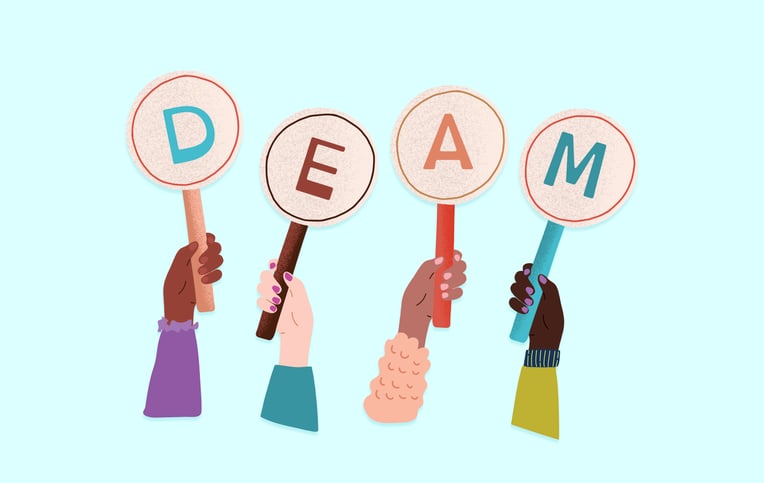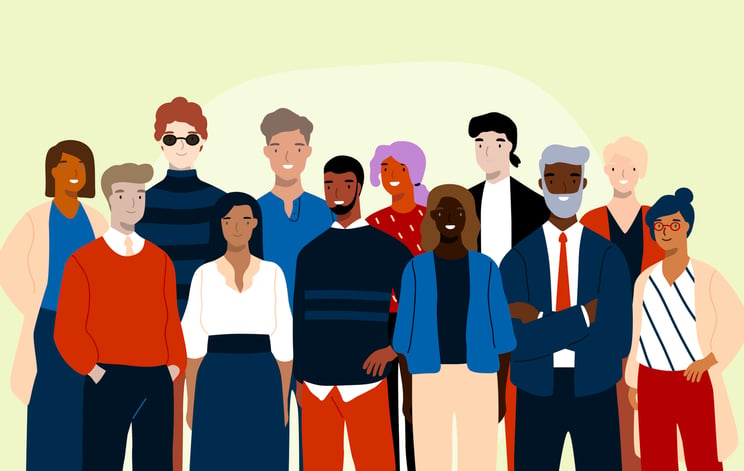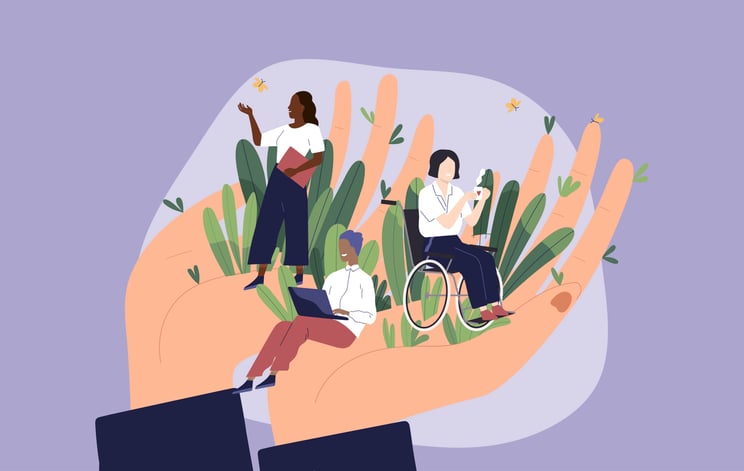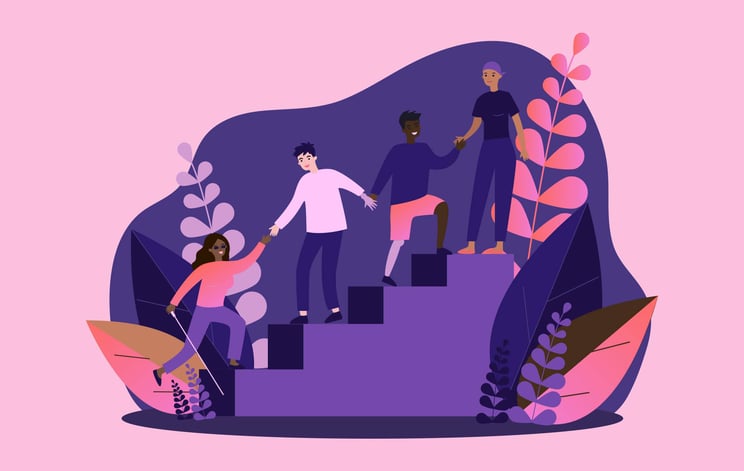An estimated 1.3 billion people currently live with a disability, according to a December 2022 global report on health equity for people with disabilities published by the World Health Organization (WHO). That amounts to roughly 16 percent of the world’s population.
While some of those are children and seniors, many are disabled workers struggling to acquire gainful employment or people facing severe discrimination in the professional world. They also encounter stereotyping colleagues, inaccessible workplaces, exclusionary employers, and material hardships.
Increasing your disability employment awareness is one way to embody the values of accessibility, inclusion, and belonging required to create meaningful change for professionals living with disabilities and beyond.

National Disability Employment Awareness Month
National Disability Employment Awareness Month (DEAM) was established in 1988 by Congress to recognize the contributions of people with disabilities in the workforce. It was an expansion of a week-long commemoration that began in 1945, and is now celebrated across the globe each October.
Discussions and initiatives focused on improving inclusiveness for professionals with disabilities in the workplace aren’t relegated to one month a year, however.
It’s critically important that companies constantly champion greater accessibility and inclusion within their organizations by instituting employment practices, policies, and programs better aligned with this mission.
Fortunately, there are plenty of ways to raise awareness about such initiatives and enhance workplace environments to better accommodate and support people with disabilities. This begins by getting a better sense of what life is like for so many within this community.

A Day in the Life of Professionals With Disabilities
Living with a disability is different for everyone, even those who have received the same diagnosis. That’s because disabilities manifest in genuinely unique ways.
It’s important to note, however, that most professionals with disabilities encounter a similar range of experiences in the workplace, from inaccessibility issues and discrimination to stereotyping and fewer opportunities for employment.
Let’s take a moment to consider the diversity of professionals living with a variety of disabilities.
‘It’s society that disables me.’
As a child, Colm McNamee’s school administrators and teachers labeled him as “slow,” recalls the neurodiversity advocate.
Now a community initiatives senior associate at cloud-based customer relationship management platform Salesforce, McNamee says he wasn’t diagnosed with autism, depression, and ADHD until age 39, neurologically related conditions subsumed under the category of neurodiversity.
Neurodivergence refers to people whose brains function in ways different from so-called neurotypical people.
Neurodivergent professionals experience persistent stigmatization, shame, and discrimination because they orient themselves in social settings in ways that run counter to what is considered “the norm.” For instance, while they frequently struggle with small talk and some social etiquette practices, they might also have unrivaled mastery of a given subject matter or skillset.
Because workplaces are often designed for the quote-unquote “average person,” many neurodivergent professionals are unable to fully contribute to their teams and communities.
McNamee is quick to note this is a design problem that needs to be addressed, rather than something neurodivergent professionals must overcome.
“I'm very much a proponent of the social model of disability,” he says, “because it's society that disables me, not my cognitive or learning style.”
Because the professional world is largely created by neurotypicals, neurodivergent team members are frequently frustrated, alienated, and have limited career development opportunities. For instance, some social protocols on the increasing number of remote teams are a challenge for neurotypical professionals, but can be even more maddening for those who are neurodivergent.
“There's this preconceived notion that when you're interviewing, you're making eye contact, and you're really engaging,” articulates Jessica Roth, a manager in Salesforce’s Office of Accessibility. “That's challenging for anyone to do right virtually, let alone someone who is neurodiverse.”
Neurodivergent professionals often encounter the challenge of lowered expectations, as well, McNamee observes. Recalling experiences earlier in life, he says: “They set the bar so low that if I could get up in the morning, there were no expectations of me.”
“I was deeply, deeply ashamed of who I was,” McNamee bemoans when reflecting on his school years in Ireland. “This had been indoctrinated into me by the society in which I had been asked to operate.”
Overcoming this will take self-advocacy and continued support from outspoken allies demanding greater inclusion and accessibility in the workplace.
‘I talk pretty well. There’s no visibility there.’
It’s hard to believe closed captioning isn’t universally available in our digital age, but that’s only one of the many obstacles that d/Deaf and hard of hearing professionals face.
Deaf in her right ear and hard of hearing in her left, Kathi Duffy is a Salesforce administrator for Benetech, a nonprofit organization dedicated to addressing economic and social inequity “through software for good.”
Deafness poses a special challenge because colleagues and clients can’t always easily discern her disability based on immediate appearance or brief interaction. Kathi Duffy says this happens frequently because she wears her hair long, concealing her hearing aid.
Since she’s gradually lost her hearing over time, Duffy says: “I talk pretty well. There’s no visibility there.” This sometimes exacerbates interactions when she mishears people. Because her hearing loss is conductive, having colleagues raise the volume of their voice doesn’t usually help.
“Think of Peanuts when the teacher does that ‘womp womp womp’ thing,” she says. “That’s kind of what I have trouble with.” Due to the shape of her eardrums, careful enunciations or asking team members to use different words often helps her brain to process language better.
Meetings can prove even more difficult, even when they employ virtual platforms with closed captioning. Live captioning is far from flawless, if it even exists on the platform a team or client chooses to use. To ensure she doesn’t miss any vital information, Duffy will routinely send follow-up emails summarizing the information she gathered and confirm with team members that she heard things properly.
‘I’m just asking for the tools to do my job.’
Blind or visually impaired (BVI) professionals continually have to push back against persistent stigmas and stereotypes to become gainfully employed.
Crystal Preston-Watson is a senior digital accessibility analyst at Salesforce who lives with impairment in both of her eyes due to keratoconus. She regularly encounters the mindset that “people with disabilities are not as productive,” Preston-Watson says. “That is a huge amount of it. And it just really is not the case.”
BVI professionals have to overcome this all the time, says Sam Proulx, accessibility evangelist at leading accessibility testing platform Fable. It can be emotionally exhausting.
“There's only so many times you can show up to an interview and you get this, 'Oh, he's blind, why is he even here?'” he says. “There's only so many times you can go through that experience and not only justify your ability to do the job but justify your own existence and your ability to do anything before it really has a profound effect on your self-image, on your happiness, on your emotional and mental well being.”
Yet, employers remain skeptical that BVI professionals are as capable as their non-disabled counterparts, a belief Preston-Watson thinks is destructive and misguided.
“There's the perception that if you're blind, you can't be a developer,” she says. “I know quite a few blind developers who are better than I could ever be.”
Professionals with disabilities are asking for simple accommodations to properly perform their jobs—requests Preston-Watson feels are no different than the ones her non-disabled peers make.
“It's the same as someone asking for a second or third monitor,” she says. “I'm asking for a screen reader. I'm just asking for the tools to do my job. People in different roles need different tools to do their jobs. And that's the same thing for disabled workers.”
‘They wanted to hire me just to comply with the law.’
Because their disabilities are often more visible than those of their peers, physically disabled professionals face a particular set of challenges. This can come in the form of being reduced to merely their disability or pressure to declare their disability status for compliance sake.
Now an equality talent partner for Salesforce, Oriana Di Stefano recalls the incredible discomfort she’s experienced with employers that are motivated more by compliance than a commitment to greater inclusion and accessibility.
Several years ago she was involved in a car accident that permanently disabled her left arm and hand. She soon returned to the workforce in her home country of Italy, where an employment law requires that at least 7 percent of people within a company with more than 50 employees must qualify as people with disabilities. Otherwise, substantial fines are levied against them.
This pressure happened throughout multiple interviews with different organizations she felt didn’t maintain equality as a central value.
“The impression I had is that they wanted to hire me just to comply with the law and not for my background, skills, and experience,” says Di Stefano. “I came under a bit of stress and, at the time, considered no longer declaring my disability status."
‘Those are challenges I face every time I sign on.’
In a world where digital interactions are so ubiquitous, exclusionary web design further alienates professionals with physical disabilities and worsens the so-called “digital divide.”
Susan LoTempio is an advisory board member for the National Center on Disability and Journalism (NCDJ) at the Walter Cronkite School of Journalism and Mass Communication at Arizona State University, and someone who uses a wheelchair. She frequently encounters exclusionary design in professional and personal settings where vital information is overlooked.
She recalls a routine example when shopping online at department store websites.
“I see several outfits I’m interested in, and read the accompanying content boxes that include sizes, colors, fabrics, and prices,” shares LoTempio. “But I need other information. If I’m on crutches, will the skirt trip me up? How will the skirt drape my body if I’m sitting in a wheelchair? Are there zippers, buttons, or other features that would be difficult for my hands or fingers to manipulate?”
The importance of representation is another important aspect of fully participating in society that’s often neglected in the professional world. Professionals with disabilities rarely see people with disabilities portrayed in marketing materials, job descriptions, or digital platforms.
“Digital inclusion also means seeing people like myself pictured on sites, content geared to my concerns and interests, and taking care not to be patronizing or insensitive,” LoTempio explains. “Those are challenges I face every time I sign on.”
Fortunately, there are many things organizations can do to become more inclusive and accessible today.

How to Create Inclusive & Accessible Work Cultures
Admittedly, meaningful cultural change takes time. And a lot of effort. While some of these cultural prescriptions will require months and years of work, you can implement some relatively quickly.
Make Virtual Meetings More Accessible & Inclusive
In our remote-working landscape, we are utilizing virtual meetings more than ever before. And while remote work makes professional life much more accessible to people living with disabilities, you’ll need to implement a few things to ensure your virtual meetings remain as inclusive as possible.
Here are six actions you can take:
- Practice Team Access Checks: Make it a routine practice at every meeting to verify that your video and audio are perfectly clear for all team members. This not only helps with accessibility, but demonstrates a clear commitment to being inclusive.
- Have Flexible Video & Audio Options: On a related note, there are times where team members need their cameras or audio off for accessibility reasons. Professionals with disabilities deserve the freedom to attend to their health needs when challenges unexpectedly arise.
- Minimize Chat Feature Use: It can be difficult, if not incredibly frustrating, for people who rely on assistive technology and screen readers to have chat going off during a virtual meeting. It often results in the two communication channels clashing with one another.
- Detail What’s Happening on Screen: Blind and visually impaired team members have a difficult time engaging with visual-heavy meetings. Presenters can augment their experience by describing what’s on screen, including presentations or, on occasion, reactions from other team members.
- Use Real-Time Captioning & Relay Services: At minimum, you should employ a virtual meeting platform that has real-time captioning. Otherwise, many of your d/Deaf or hard-of-hearing team members will not have equitable access to your meetings. Going a step further, you can utilize a relay service, such as interpreters who can provide sign language during meetings.
- Record All Virtual Meetings: By recording every meeting, you not only help team members who had to step away to attend to a health need, but make it easier to review meeting content later.
Create Psychological Safety
To cope with a less accessible milieu, many people “mask” their disabilities, especially neurodivergent professionals. In fact, neurodivergent masking is a common coping mechanism they use to conceal aspects of their neurodivergent traits to better fit in with workplace norms.
For instance, many neurodivergent professionals exhaust themselves trying to filter their thoughts or speech in ways that resemble their neurotypical peers. In other words, concealing their more natural way of orienting in the world can induce feelings of shame and fear and undercut their self-esteem.
As a result, autistic professionals also tend to struggle more than others with the practice of building and maintaining the network necessary for getting promotions and advancing their careers.
When reflecting on her own experiences with masking, Transformation Consulting Director at Salesforce Veronica Pillon recalls the constant ruminations: “What’s wrong? Why don’t I fit in?”
For her, being neurodiverse is like having “this sensation where you’re always a minute late.” However, working in a psychologically safe culture has made all the difference.
Psychological safety is about establishing team norms where nobody worries about being chastised, mocked, or disciplined for honesty about their concerns or past mistakes and all feel free to express their ideas. As you can imagine, this is particularly beneficial for autistic professionals who tend to filter their thoughts differently than neurotypical professionals.
Pillon believes psychological safety means “encouraging your team to take risks to be themselves, to not feel judged,” she says. “It's the greatest thing a company can do.”
Compared to earlier portions of her professional life, she says having an understanding supervisor has meant the world to her feeling psychologically safe.
“He does it every day,” she remarks. “I am me. Yes, I wear a ‘mask’ with clients, but my core self is safe.“
Improve Your Interview Process
Professionals with disabilities know all too well the experience of having an interview start off positive, only to have the recruiter’s tone dramatically change upon discovering they have a disability. For this reason, many disabled professionals have adapted by exercising caution.
“You have to be really careful,” notes Darrell Hilliker, an accessibility support engineer who was born blind due to glaucoma. “You have to do as much as you can to sort of prove yourself before you disclose [your disability].”
Like many professionals with disabilities, he avoids disclosing his disability status pre-interview when applying for a job due to persistent discrimination in the process.
“Because social attitudes are so poor,” he continues, “I think most HR people, even in the twenty-first century, would still pre-screen you out.”
Alternatively, companies are addressing these exclusionary practices by adopting a more inclusive interviewing process—for instance, using intentional language in job descriptions and jettisoning misguided stereotypes about the supposed underproductivity of disabled workers.
By asking job candidates to list any of their accommodation needs during the interview process, you can attract more professionals with disabilities and signal to potential employees your commitment to inclusion and accessibility. Furthermore, you can post job openings on platforms such as Inclusively, a place “like Indeed or LinkedIn specifically for people with disabilities,” says Jessica Roth, a work manager in Salesforce’s Office of Accessibility.
When conducting interviews, employers should also consider flexible formats depending on the candidate’s accommodation needs. For instance, permitting neurodiverse professionals to interview one-on-one rather than in a group setting or allowing flexible interview times for professionals with so-called “invisible disorders” who experience unexpected health challenges at certain parts of the day can be liberating.
Maintain Disability Representation in Leadership
In addition to seeing people who look like you appear on company websites or in marketing collateral, encountering disability representation in leadership is equally important.
Sadly, very few workers have this experience.
Of the 415 companies that participated in the 2022 Disability Equality Index published by global business disability inclusion nonprofit Disability:IN—including 69 of the Fortune 100 and 188 of the Fortune 500—a mere 6% have “someone who openly identifies as having a disability serving on their company’s corporate Board of Directors.”
This echoes the very real career obstacles and grievances professionals with disabilities frequently encounter.
“You can imagine the power of having someone [with a disability] that is at the VP level, or a senior director level, and I'm at the director level,” says Veronica Pillon, Transformation Consulting Director at Salesforce. “But I know that I have possibly reached a glass ceiling.”
On the other hand, when your organization has leaders living with disabilities, you demonstrate your commitment to accessibility, inclusion, and belonging.
You also ensure viewpoints of disabled professionals are included in the overall vision and direction of your company. Progress for the disabilities community has been slowed because people living with disabilities have historically been excluded from seats of power and decision-making roles.
It’s easy to overlook the needs of disabled professionals when they don’t have a position at the table. That needs to change.

Leverage Your Understanding
Greater inclusion and accessibility are becoming a higher priority for many organizations, but everyone can do more to ensure professionals with disabilities both have a seat at the table and feel they belong.
Take the time to better understand the challenges your colleagues with disabilities experience professionally, and leverage that understanding to build a more inclusive workspace.
Life will be better for our disabled colleagues. Our organizations will better address the needs of more people. And our communities will better reflect the values of a more equitable society.
Additional Resources
- Implement Remote Work Policies:It’s a truism that what ends up making daily life more accessible for disabled people also tends to make life better for their non-disabled peers. The increased popularity of remote working policies is no exception. Work-from-anywhere policies introduce a much greater degree of accessibility options for employees, as well, empowering them to create work routines that suit their autonomy and assistance preferences.
- Breaking Down Systemic Barriers: Greater accessibility and inclusion will not come by businesses alone changing their cultures and practices. Public policy has a part to play, as well. By combining policy-driven efforts with cultural shifts, we can augment the campaign to ensure the professional world works for all people, regardless of disability status.
- The InclusionHub Podcast: Hosted by leading accessibility testing platform Fable’s accessibility evangelist Sam Proulx, this podcast features interviews with prominent activists and advocates exploring the many facets of digital accessibility and inclusion, from the early days of the disability rights movement to the present state of the internet—because “a more accessible and inclusive world is a better world.”
Salesforce is a founding partner of InclusionHub, an online directory and digital resource for organizations aspiring to be more inclusive and accessible. Explore our crowd-sourced database to learn more about ways you can support disabled professionals within your organization.


